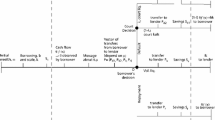Abstract
This paper analyzes how an enforcement mechanism that resembles a court affects firm finance. The court is described by two parameters that correspond to enforcement costs and the amount of creditor/debtor protection. We provide a theoretical and quantitative characterization of the effect of these enforcement parameters on the contract loan rate, the default probability and welfare. We analyze agents’ incentive to default and pursue bankruptcy and show that when the constraints that govern these decisions bind, the enforcement parameters can have a sharply non-linear effect on finance. We also compute the welfare losses of “poor institutions” and show that they are non-trivial. The results provide guidance on when models which abstract from enforcement provide good approximations and when they do not.
Similar content being viewed by others
References
Altman, E.I., Bana, G.: Defaults and returns on high yield bonds: Analysis through september 30, 2002. working paper: New York University, Stern School of Business (2002)
Antinolfi G., Huybens E. (1998) Capital accumulation and real exchange rate behavior in a small open economy with credit market frictions. Econ Theory 12, 461–488
Antinolfi G., Huybens E. (2004) Domestic financial market frictions, unrestricted international capital flows, and crises in small open economies. Econ Theory 24, 811–837
Athreya K. (2002) Welfare implications of the bankruptcy reform act of 1999. J Monetary Econ 49, 1567–1595
Azariadis C., Kaas L. (2007) Is dynamic general equilibrium a theory of everything?. Econ Theory 32, 13–41
Bond P. (2003) Incentive compatible contractable information. Econ Theory 22, 375–394
Boyd J., Levine R., Smith B. (2001) The impact of inflation on financial sector performance. J Monetary Econ 47, 221–248
Boyd J., Smith B. (1994) How good are standard debt contracts? Stochastic versus non stochastic monitoring in a costly state verification environment. J Bus 67, 539–561
Carlier G., Renou L. (2005) A costly state verification model with diversity of opinions. Econ Theory 25, 497–504
Carlier G., Renou L. (2006) Debt contracts with ex-ante and ex-post asymmetric information: an example. Econ Theory 28, 461–473
Chatterjee, S., Corbae, D., Nakajima, M., Rios-Rull, V.: A quantitative theory of unsecured consumer credit with risk of default. Econometrica (forthcoming, 2007)
Fama, E., French, K.: Industry costs of equity. J Fin Econ 43, 153–193
Gale D., Hellwig M. (1985) Incentive-compatible debt contracts: the one period problem. Rev Econ Stud 52, 647–663
Herranz, N., Krasa, S., Villamil, A.: The impact of entrepreneur characteristics and bankruptcy rules on firm performance. Working Paper, University of Illinois (2007)
Hillegeist S., Keating E., Cram D., Lundstedt K. (2004) Assessing the probability of bankruptcy. Rev Account Stud 9, 5–34
Jeong H., Townsend R. (2007) Sources of TFP growth: Occupational choice and financial deepening. Econ Theory 32, 179–221
Krasa S., Sharma T., Villamil A. (2005) Debt contracts and cooperative improvements. J Math Econ 41, 857–874
Krasa, S., Sharma, T., Villamil, A.: Enforcement and credit rationing. Working Paper, University of Illinois (2007)
Krasa S., Villamil A. (2000) Optimal contracts when enforcement is a decision variable. Econometrica 68, 119–134
La Porta R., de Silanes F.L., Shleifer A., Vishny R. (1998) Law and finance. J Polit Econ 106, 1113–1155
Lawless, R., Ferris, S.: Professional fees and other direct costs in chap 7 bankruptcies. Washington University Law Quarterly, http://ls.wustl.edu/WULQ/ 75, 1207 (1997)
Livshits I., MacGee J., Tertilt M. (2007) Consumer bankruptcy: a fresh start. Am Econ Rev 97, 402–418
Smith B. (1998) Informational asymmetries in macroeconomics and finance. Econ Theory 12, 451–460
Townsend R. (1979) Optimal contracts and competitive markets with costly state verification. J Econ Theory 2, 1–29
Williamson S. (1986) Costly monitoring, financial intermediation, and equilibrium credit rationing. J Monetary Econ 18, 159–179
Author information
Authors and Affiliations
Corresponding author
Rights and permissions
About this article
Cite this article
Krasa, S., Sharma, T. & Villamil, A.P. Bankruptcy and firm finance. Economic Theory 36, 239–266 (2008). https://doi.org/10.1007/s00199-007-0267-y
Received:
Revised:
Published:
Issue Date:
DOI: https://doi.org/10.1007/s00199-007-0267-y
Keywords
- Enforcement
- Default
- Bankruptcy
- Legal environment
- Contracts
- Limited commitment
- Debt
- Creditor protection
- Inflation




